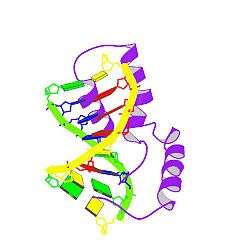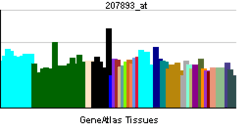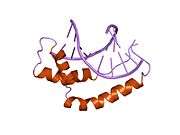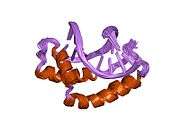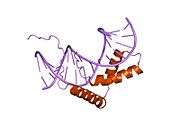Testis-determining factor
| View/Edit Human | |||
Testis-determining factor (TDF), also known as sex-determining region Y (SRY) protein, is a DNA-binding protein (also known as gene-regulatory protein/transcription factor) encoded by the SRY gene that is responsible for the initiation of male sex determination in humans.[2] SRY is an intronless sex-determining gene on the Y chromosome in therians (placental mammals and marsupials);[3] mutations in this gene lead to a range of sex-related disorders with varying effects on an individual's phenotype and genotype.
TDF is a member of the SOX (SRY-like box) gene family of DNA-binding proteins. When complexed with the SF1 protein, TDF acts as a transcription factor that can upregulate other transcription factors, most importantly SOX9.[4] Its expression causes the development of primary sex cords, which later develop into seminiferous tubules. These cords form in the central part of the yet-undifferentiated gonad, turning it into a testis. The now-induced Leydig cells of the testis then start secreting testosterone, while the Sertoli cells produce anti-Müllerian hormone.[5] SRY gene effects normally take place 6–8 weeks after foetus formation and inhibits the female anatomical structural growth in males. It also works towards developing the dominant male characteristics.
Gene evolution and regulation
Evolution
SRY may have arisen from a gene duplication of the X chromosome bound gene SOX3, a member of the Sox family.[6] This duplication occurred after the split between monotremes and therians. Monotremes lack SRY and some of their sex chromosomes share homology with bird sex chromosomes.[7] SRY is a quickly evolving gene and its regulation has been difficult to study because sex determination is not a highly conserved phenomenon within the animal kingdom. [8]
Regulation
SRY gene has little in common with sex determination genes of other model organisms, and mice are the main model research organisms that can be utilized for its study. Understanding its regulation is further complicated because even between mammalian species, there is little protein sequence conservation. The only conserved group between mice and mammals is the High-mobility group (HMG) box region that is responsible for DNA binding. Mutations in this region result in sex reversal, where the opposite sex is produced.[9] Because there is little conservation, the SRY promoter, regulatory elements and regulation are not well understood. Within related mammalian groups there are homologies within the first 400-600 base pairs upstream from the translational start site. In vitro studies of human SRY promoter have shown that a region of at least 310 bp upstream to translational start site are required for SRY promoter function. It's been shown that binding of three transcription factors, Steroidogenic factor 1 (SF1), Specificity Protein 1 (Sp1 transcription factor) and Wilms tumor protein 1 (WT1), to the human promoter sequence, influence expression of SRY.[9]
The promoter region has two Sp1 binding sites, at -150 and -13 that function as regulatory sites. Sp1 is a transcription factor that binds GC-rich consensus sequences, and mutation of the SRY binding sites leads to a 90% reduction in gene transcription. Studies of SF1 have resulted in less definite results. Mutations of SF1 can lead to sex reversal and deletion lead to incomplete gonad development. However, it's not clear how SF1 interacts with the SR1 promoter directly.[10] The promoter region also has two WT1 binding sites at -78 and -87 bp from the ATG codon. WT1 is transcription factor that has four C-terminal Zinc fingers and an N-terminal Pro/Glu-rich region and primarily functions as an activator. Mutation of the Zinc fingers or inactivation of WT1 results in reduced male gonad size. Deletion of the gene resulted in complete sex reversal. It is not clear how WT1 functions to up-regulate SRY, but some research suggests that it helps stabilize message processing.[10] However, there are complications to this hypothesis, because WT1 also is responsible for expression of an antagonist of male development, DAX1, which stands for Dosage-sensitive sex reversal, Adrenal hypoplasia critical region, on chromosome X, gene 1 . An additional copy of DAX1 in mice leads to sex reversal. It is not clear how DAX1 functions, and many different pathways have been suggested, including SRY transcriptional destabilization and RNA binding. There is evidence from work on suppression of male development that DAX1 can interfere with function of SF1, and in turn transcription of SRY by recruiting corepressors.[9]
There is also evidence that GATA binding protein 4 (GATA4) and FOG2 contribute to activation of SRY by associating with its promoter. How these proteins regulate SRY transcription is not clear, but FOG2 and GATA4 mutants have significantly lower levels of SRY transcription.[11] FOGs have zinc finger motifs that can bind DNA, but there is no evidence of FOG2 interaction with SRY. Studies suggest that FOG2 and GATA4 associate with nucleosome remodeling proteins that could lead to its activation.[12]
Function
During gestation, the cells of the primordial gonad that lie along the urogenital ridge are in a bipotential state, meaning they possess the ability to become either male cells (Sertoli and Leydig cells) or female cells (follicle cells and Theca cells). TDF initiates testis differentiation by activating male-specific transcription factors that allow these bipotential cells to differentiate and proliferate. TDF accomplishes this by upregulating SOX9, a transcription factor with a DNA-binding site very similar to TDF's. SOX9 leads to the upregulation of fibroblast growth factor 9 (Fgf9), which in turn leads to further upregulation of SOX9 . Once proper SOX9 levels are reached, the bipotential cells of the gonad begin to differentiate into Sertoli cells. Additionally, cells expressing TDF will continue to proliferate to form the primordial testis. While this constitutes the basic series of events, this brief review should be taken with caution since there are many more factors that influence sex differentiation.
Action in the nucleus
The TDF protein consists of three main regions. The central region encompasses the HMG (high-mobility group) domain, which contains nuclear localization sequences and acts as the DNA-binding domain. The C-terminal domain has no conserved structure, and the N-terminal domain can be phosphorylated to enhance DNA-binding.[10] The process begins with nuclear localization of TDF by acetylation of the nuclear localization signal regions, which allows for the binding of importin β and calmodulin to TDF, facilitating its import into the nucleus. Once in the nucleus, TDF and SF1 (steroidogenic factor 1, another transcriptional regulator) complex and bind to TESCO (testis-specific enhancer of Sox9 core), the testes-specific enhancer element of the Sox9 gene in Sertoli cell precursors, located upstream of the Sox9 gene transcription start site.[4] Specifically, it is the HMG region of TDF that binds to the minor groove of the DNA target sequence, causing the DNA to bend and unwind. The establishment of this particular DNA “architecture” facilitates the transcription of the Sox9 gene.[10] SOX9 protein then initiates a positive feedback loop, involving SOX9 acting as its own transcription factor and resulting in the synthesis of large amounts of SOX9.[10]
SOX9 and testes differentiation
The SF1 protein, on its own, leads to minimal transcription of the SOX9 gene in both the XX and XY bipotential gonadal cells along the urogenital ridge. However, binding of the TDF-SF1 complex to the testis-specific enhancer (TESCO) on SOX9 leads to significant up-regulation of the gene in only the XY gonad, while transcription in the XX gonad remains negligible. Part of this up-regulation is accomplished by SOX9 itself through a positive feedback loop; like TDF, SOX9 complexes with SF1 and binds to the TESCO enhancer, leading to further expression of SOX9 in the XY gonad. Two other proteins, FGF9 (fibroblast growth factor 9) and PDG2 (prostaglandin D2), also maintain this up-regulation. Although their exact pathways are not fully understood, they have been proven to be essential for the continued expression of SOX9 at the levels necessary for testes development.[4]
SOX9 and TDF are believed to be responsible for the cell-autonomous differentiation of supporting cell precursors in the gonads into Sertoli cells, the beginning of testes development. These initial Sertoli cells, in the center of the gonad, are hypothesized to be the starting point for a wave of FGF9 that spreads throughout the developing XY gonad, leading to further differentiation of Sertoli cells via the up-regulation of SOX9.[13] SOX9 and TDF are also believed to be responsible for many of the later processes of testis development (such as Leydig cell differentiation, sex cord formation, and formation of testis-specific vasculature), although exact mechanisms remain unclear.[14] It has been shown, however, that SOX9, in the presence of PDG2, acts directly on Amh (encoding anti-Müllerian hormone) and is capable of inducing testis formation in XX mice gonads, indicating its vital to testes development.[13]
Influence on sex
Embryos are gonadally identical, regardless of genetic sex, until a certain point in development when the testis-determining factor causes male sex organs to develop. Therefore, SRY plays an important role in sex determination. A typical male karyotype is XY. Individuals who inherit a normal Y chromosome and multiple X chromosomes are generally male (such as in Klinefelter Syndrome, which has an XXY karyotype). Atypical genetic recombination during crossover when a sperm cell is developing can result in karyotypes that do not match their phenotypic expression.
Most of the time, when a developing sperm cell undergoes crossover during its meiosis, the SRY gene stays on the Y chromosome. If it is transferred to the X chromosome, however, the resulting Y chromosome will not have an SRY gene and can no longer initiate testis development. Offspring which inherit this Y chromosome will have Swyer syndrome, characterized by an XY karyotype and a female phenotype. The X chromosome that results from this crossover event now has a SRY gene, and therefore the ability to initiate testis development. Offspring who inherit this X chromosome will have a condition called XX male syndrome, characterized by an XX karyotype, and a male phenotype. While most XX males develop testis, it is possible for them to experience incomplete differentiation resulting in the formation of both testicular and ovarian tissues in the same individual. XX male syndrome results in infertility, most likely caused by the inactivation (either random or non-random) of the X chromosome containing the SRY in some cells.[15]
While the presence or absence of SRY has generally determined whether or not testis development occurs, it has been suggested that there are other factors that affect the functionality of SRY.[16] Therefore, there are individuals who have the SRY gene, but still develop as females, either because the gene itself is defective or mutated, or because one of the contributing factors is defective.[17] This can happen in individuals exhibiting a XY, XXY, or XX SRY-positive karyotype.
Role in other diseases
SRY has been shown to interact with the androgen receptor and individuals with XY karyotype and a functional SRY gene can have an outwardly female phenotype due to an underlying androgen insensitivity syndrome (AIS).[18] Individuals with AIS are unable to respond to androgens properly due to a defect in their androgen receptor gene, and affected individuals can have complete or partial AIS.[19] SRY has also been linked to the fact that males are more likely than females to develop dopamine-related diseases such as schizophrenia and Parkinson's disease. SRY encodes a protein that controls the concentration of dopamine, the neurotransmitter that carries signals from the brain that control movement and coordination.[20]
Use in Olympic screening
One of the most controversial uses of this discovery was as a means for gender verification at the Olympic Games, under a system implemented by the International Olympic Committee in 1992. Athletes with an SRY gene were not permitted to participate as females, although all athletes in whom this was "detected" at the 1996 Summer Olympics were ruled false positives and were not disqualified. Specifically, eight female participants (out of a total of 3387) at these games were found to have the SRY gene. However, after further investigation of their genetic conditions, all these athletes were verified as female and allowed to compete. These athletes were found to have either partial or full androgen insensitivity, despite having an SRY gene, making them phenotypically female and giving them no advantage over other female competitors.[21] In the late 1990s, a number of relevant professional societies in United States called for elimination of gender verification, including the American Medical Association, stating that the method used was uncertain and ineffective.[22] The screening was eliminated as of the 2000 Summer Olympics.[22][23][24] Since this method of testing was eliminated there has been no form of Olympic gender screening that all athletes must undergo. Rather, questions regarding an athlete's gender are now addressed on an individual basis by medical experts, only when there is significant reason to suspect a male athlete may be posing as a female. However, there have been few, if any, instances of such suspicion and evaluation since the system of screening was eliminated, due to the difficulties and impracticality of a male successfully disguising himself as a female athlete (such as the nature of women's event uniforms, which make concealment of a male's body near impossible).[21]
Ongoing research
Despite the progress made during the past several decades in the study of sex determination, the SRY gene, and the TDF protein, work is still being done to further our understanding in these areas. There remain factors that need to be identified in the sex-determining molecular network, and the chromosomal changes involved in many other human sex-reversal cases are still unknown. Scientists continue to search for additional sex-determining genes, using techniques such as microarray screening of the genital ridge genes at varying developmental stages, mutagenesis screens in mice for sex-reversal phenotypes, and identifying the genes that transcription factors act on using chromatin immunoprecipitation.[10]
See also
References
- ↑ "Human PubMed Reference:".
- ↑ Berta P, Hawkins JR, Sinclair AH, Taylor A, Griffiths BL, Goodfellow PN, Fellous M (November 1990). "Genetic evidence equating SRY and the testis-determining factor". Nature. 348 (6300): 448–50. Bibcode:1990Natur.348..448B. doi:10.1038/348448A0. PMID 2247149.
- ↑ Wallis MC, Waters PD, Graves JA (June 2008). "Sex determination in mammals - Before and after the evolution of SRY". Cell. Mol. Life Sci. 65 (20): 3182–95. doi:10.1007/s00018-008-8109-z. PMID 18581056.
- 1 2 3 Kashimada K, Koopman P (December 2010). "Sry: the master switch in mammalian sex determination". Development. 137 (23): 3921–30. doi:10.1242/dev.048983. PMID 21062860.
- ↑ Mittwoch U (October 1988). "The race to be male". New Scientist. 120 (1635): 38–42.
- ↑ Katoh K, Miyata T (1999). "A heuristic approach of maximum likelihood method for inferring phylogenetic tree and an application to the mammalian SOX-3 origin of the testis-determining gene SRY". FEBS Lett. 463 (1–2): 129–32. doi:10.1016/S0014-5793(99)01621-X. PMID 10601652.
- ↑ Veyrunes F, Waters PD, Miethke P, Rens W, McMillan D, Alsop AE, Grützner F, Deakin JE, Whittington CM, Schatzkamer K, Kremitzki CL, Graves T, Ferguson-Smith MA, Warren W, Marshall Graves JA (June 2008). "Bird-like sex chromosomes of platypus imply recent origin of mammal sex chromosomes". Genome Res. 18 (6): 965–73. doi:10.1101/gr.7101908. PMC 2413164
 . PMID 18463302.
. PMID 18463302. - ↑ Bowles J, Schepers G, Koopman P (2000). "Phylogeny of the SOX family of developmental transcription factors based on sequence and structural indicators". Dev Biol. 227 (2): 239–55. doi:10.1006/dbio.2000.9883. PMID 11071752.
- 1 2 3 Ely D, Underwood A, Dunphy G, Boehme S, Turner M, Milsted A (November 2010). "Review of the Y chromosome, Sry and hypertension". Steroids. 75 (11): 747–53. doi:10.1016/j.steroids.2009.10.015. PMC 2891862
 . PMID 19914267.
. PMID 19914267. - 1 2 3 4 5 6 Harley VR, Clarkson MJ, Argentaro A (August 2003). "The molecular action and regulation of the testis-determining factors, SRY (sex-determining region on the Y chromosome) and SOX9 [SRY-related high-mobility group (HMG) box 9]". Endocr. Rev. 24 (4): 466–87. doi:10.1210/er.2002-0025. PMID 12920151.
- ↑ Knower KC, Kelly S, Harley VR (2003). "Turning on the male--SRY, SOX9 and sex determination in mammals" (PDF). Cytogenet. Genome Res. 101 (3-4): 185–98. doi:10.1159/000074336. PMID 14684982.
- ↑ Friedman, Theodore (2011). Advances in Genetics Vol 76. 108: Elsevier Inc.
- 1 2 McClelland K, Bowles J, Koopman P (January 2012). "Male sex determination: insights into molecular mechanisms". Asian J. Androl. 14 (1): 164–71. doi:10.1038/aja.2011.169. PMC 3735148
 . PMID 22179516.
. PMID 22179516. - ↑ Sekido R, Lovell-Badge R (2013). "Genetic control of testis development". Sex Dev. 7 (1–3): 21–32. doi:10.1159/000342221. PMID 22964823.
- ↑ Margarit E, Coll MD, Oliva R, Gómez D, Soler A, Ballesta F (January 2000). "SRY gene transferred to the long arm of the X chromosome in a Y-positive XX true hermaphrodite". Am. J. Med. Genet. 90 (1): 25–8. doi:10.1002/(SICI)1096-8628(20000103)90:1<25::AID-AJMG5>3.0.CO;2-5. PMID 10602113.
- ↑ Polanco JC, Koopman P (February 2007). "Sry and the hesitant beginnings of male development". Dev. Biol. 302 (1): 13–24. doi:10.1016/j.ydbio.2006.08.049. PMID 16996051.
- ↑ Biason-Lauber A, Konrad D, Meyer M, DeBeaufort C, Schoenle EJ (May 2009). "Ovaries and female phenotype in a girl with 46,XY karyotype and mutations in the CBX2 gene". Am. J. Hum. Genet. 84 (5): 658–63. doi:10.1016/j.ajhg.2009.03.016. PMC 2680992
 . PMID 19361780.
. PMID 19361780. - ↑ Yuan X, Lu ML, Li T, Balk SP (December 2001). "SRY interacts with and negatively regulates androgen receptor transcriptional activity". J. Biol. Chem. 276 (49): 46647–54. doi:10.1074/jbc.M108404200. PMID 11585838.
- ↑ Lister Hill National Center for Biomedical Communications (2008). "Androgen insensitivity syndrome". Genetics Home Reference. U.S. National Library of Medicine.
- ↑ Dewing P, Chiang CW, Sinchak K, Sim H, Fernagut PO, Kelly S, Chesselet MF, Micevych PE, Albrecht KH, Harley VR, Vilain E (February 2006). "Direct regulation of adult brain function by the male-specific factor SRY". Curr. Biol. 16 (4): 415–20. doi:10.1016/j.cub.2006.01.017. PMID 16488877.
- 1 2 "Olympic Gender Testing".
- 1 2 Facius GM (2004-08-01). "The Major Medical Blunder of the 20th Century". Gender Testing. facius-homepage.dk. Archived from the original on 26 January 2010. Retrieved 2011-06-12.
- ↑ Elsas LJ, Ljungqvist A, Ferguson-Smith MA, Simpson JL, Genel M, Carlson AS, Ferris E, de la Chapelle A, Ehrhardt AA (2000). "Gender verification of female athletes". Genet. Med. 2 (4): 249–54. doi:10.1097/00125817-200007000-00008. PMID 11252710.
- ↑ Dickinson BD, Genel M, Robinowitz CB, Turner PL, Woods GL (October 2002). "Gender verification of female Olympic athletes". Med Sci Sports Exerc. 34 (10): 1539–42; discussion 1543. doi:10.1097/00005768-200210000-00001. PMID 12370551.
Further reading
- Haqq CM, King CY, Ukiyama E, Falsafi S, Haqq TN, Donahoe PK, Weiss MA (December 1994). "Molecular basis of mammalian sexual determination: activation of Müllerian inhibiting substance gene expression by SRY". Science. 266 (5190): 1494–500. doi:10.1126/science.7985018. PMID 7985018.
- Goodfellow PN, Lovell-Badge R (1993). "SRY and sex determination in mammals". Annu. Rev. Genet. 27: 71–92. doi:10.1146/annurev.ge.27.120193.000443. PMID 8122913.
- Hawkins JR (1993). "Mutational analysis of SRY in XY females". Hum. Mutat. 2 (5): 347–50. doi:10.1002/humu.1380020504. PMID 8257986.
- Harley VR (2002). "The molecular action of testis-determining factors SRY and SOX9". Novartis Found. Symp. Novartis Foundation Symposia. 244: 57–66; discussion 66–7, 79–85, 253–7. doi:10.1002/0470868732.ch6. ISBN 978-0-470-86873-7. PMID 11990798.
- Jordan BK, Vilain E (2003). "Sry and the genetics of sex determination". Adv. Exp. Med. Biol. Advances in Experimental Medicine and Biology. 511: 1–13; discussion 13–4. doi:10.1007/978-1-4615-0621-8_1. ISBN 978-1-4613-5162-7. PMID 12575752.
- Oh HJ, Lau YF (2006). "KRAB: a partner for SRY action on chromatin". Mol. Cell. Endocrinol. 247 (1–2): 47–52. doi:10.1016/j.mce.2005.12.011. PMID 16414182.
- Polanco JC, Koopman P (2007). "Sry and the hesitant beginnings of male development". Dev. Biol. 302 (1): 13–24. doi:10.1016/j.ydbio.2006.08.049. PMID 16996051.
- Hawkins JR, Taylor A, Berta P, Levilliers J, Van der Auwera B, Goodfellow PN (February 1992). "Mutational analysis of SRY: nonsense and missense mutations in XY sex reversal". Hum. Genet. 88 (4): 471–4. doi:10.1007/BF00215684. PMID 1339396.
- Hawkins JR, Taylor A, Goodfellow PN, Migeon CJ, Smith KD, Berkovitz GD (November 1992). "Evidence for increased prevalence of SRY mutations in XY females with complete rather than partial gonadal dysgenesis". Am. J. Hum. Genet. 51 (5): 979–84. PMC 1682856
 . PMID 1415266.
. PMID 1415266. - Ferrari S, Harley VR, Pontiggia A, Goodfellow PN, Lovell-Badge R, Bianchi ME (December 1992). "SRY, like HMG1, recognizes sharp angles in DNA". EMBO J. 11 (12): 4497–506. PMC 557025
 . PMID 1425584.
. PMID 1425584. - Jäger RJ, Harley VR, Pfeiffer RA, Goodfellow PN, Scherer G (December 1992). "A familial mutation in the testis-determining gene SRY shared by both sexes". Hum. Genet. 90 (4): 350–5. doi:10.1007/BF00220457. PMID 1483689.
- Vilain E, McElreavey K, Jaubert F, Raymond JP, Richaud F, Fellous M (May 1992). "Familial case with sequence variant in the testis-determining region associated with two sex phenotypes". Am. J. Hum. Genet. 50 (5): 1008–11. PMC 1682588
 . PMID 1570829.
. PMID 1570829. - Müller J, Schwartz M, Skakkebaek NE (July 1992). "Analysis of the sex-determining region of the Y chromosome (SRY) in sex reversed patients: point-mutation in SRY causing sex-reversion in a 46,XY female". J. Clin. Endocrinol. Metab. 75 (1): 331–3. doi:10.1210/jc.75.1.331. PMID 1619028.
- McElreavey KD, Vilain E, Boucekkine C, Vidaud M, Jaubert F, Richaud F, Fellous M (July 1992). "XY sex reversal associated with a nonsense mutation in SRY". Genomics. 13 (3): 838–40. doi:10.1016/0888-7543(92)90164-N. PMID 1639410.
- Sinclair AH, Berta P, Palmer MS, Hawkins JR, Griffiths BL, Smith MJ, Foster JW, Frischauf AM, Lovell-Badge R, Goodfellow PN (July 1990). "A gene from the human sex-determining region encodes a protein with homology to a conserved DNA-binding motif". Nature. 346 (6281): 240–4. doi:10.1038/346240a0. PMID 1695712.
- Berkovitz GD, Fechner PY, Zacur HW, Rock JA, Snyder HM, Migeon CJ, Perlman EJ (November 1991). "Clinical and pathologic spectrum of 46,XY gonadal dysgenesis: its relevance to the understanding of sex differentiation". Medicine (Baltimore). 70 (6): 375–83. doi:10.1097/00005792-199111000-00003. PMID 1956279.
- Berta P, Hawkins JR, Sinclair AH, Taylor A, Griffiths BL, Goodfellow PN, Fellous M (November 1990). "Genetic evidence equating SRY and the testis-determining factor". Nature. 348 (6300): 448–50. doi:10.1038/348448A0. PMID 2247149.
- Jäger RJ, Anvret M, Hall K, Scherer G (November 1990). "A human XY female with a frame shift mutation in the candidate testis-determining gene SRY". Nature. 348 (6300): 452–4. doi:10.1038/348452a0. PMID 2247151.
- Ellis NA, Goodfellow PJ, Pym B, Smith M, Palmer M, Frischauf AM, Goodfellow PN (January 1989). "The pseudoautosomal boundary in man is defined by an Alu repeat sequence inserted on the Y chromosome". Nature. 337 (6202): 81–4. doi:10.1038/337081a0. PMID 2909893.
- Whitfield LS, Hawkins TL, Goodfellow PN, Sulston J (May 1995). "41 kilobases of analyzed sequence from the pseudoautosomal and sex-determining regions of the short arm of the human Y chromosome". Genomics. 27 (2): 306–11. doi:10.1006/geno.1995.1047. PMID 7557997.
External links
| Wikimedia Commons has media related to SRY. |
- GeneReviews/NCBI/NIH/UW entry on 46,XX Testicular Disorder of Sex Development
- OMIM entries on 46,XX Testicular Disorder of Sex Development
- Genes, sry at the US National Library of Medicine Medical Subject Headings (MeSH)
- Sex-Determining Region Y Protein at the US National Library of Medicine Medical Subject Headings (MeSH)
